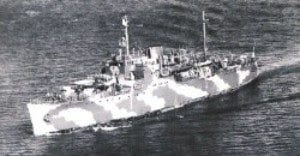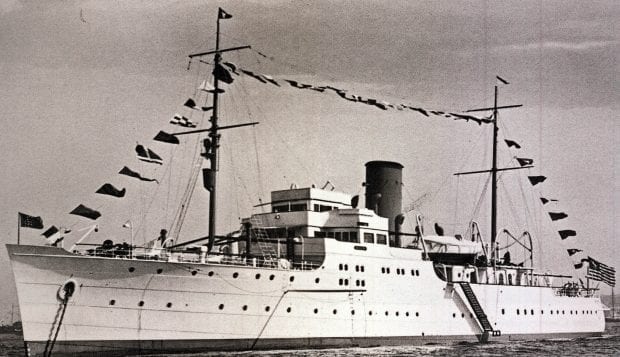William K. Vanderbilt II (1878–1944) spent years dreaming of and designing his 264-foot yacht Alva. The luxurious ship, named after his mother, Alva Vanderbilt Belmont, was custom built at the Krupp-Germaniawerft shipyard in Kiel, Germany, on a design by Cox & Stephens. It was powered by two diesel engines with an auxiliary electric motor. Top speed was 16 knots.
On Aug. 5, the Suffolk County Vanderbilt Museum marked the 75th anniversary of the yacht’s wartime service and recalled its tragic sinking on Aug. 5, 1943.
Aboard the Alva, steaming out of Kiel on March 5, 1931, William and Rosamond Vanderbilt began the ship’s inaugural voyage from Europe to Miami and then New York. The trip was preparation for their epic seven-month circumnavigation of the globe that began in July of that year. During the voyage, Vanderbilt collected marine life, invertebrates and cultural artifacts for his Centerport museum.
Ten years, later, just before the United States entered World War II, President Franklin D. Roosevelt asked yacht owners to donate their boats to the U.S. Navy. Vanderbilt answered the call.

Photo from Vanderbilt Museum
On Nov. 4, 1941, a month before the attack on Pearl Harbor, he gave the Alva to the Navy, which converted it to a patrol gunboat. The ship was renamed the USS Plymouth (PG 57).
The Vanderbilt family had served in every major conflict since the War of 1812. In 1917, William Vanderbilt was commissioned as a lieutenant commander in the U.S. Naval Reserve. From May 9 to Oct. 1, 1917, he patrolled U.S. coastal waters in his ship Tarantula II.
The following details of the Alva’s life as the USS Plymouth are from the Vanderbilt Museum archives and from Uboat.net, a history website based in Iceland with contributing writers from Germany, the United States, Canada and Europe:
On April 20, 1942, the Plymouth was commissioned and based in Norfolk, Virginia. Assigned to the Inshore Patrol Squadron in the 5th Naval District, she made several convoy escort voyages between New York, Key West and Guantanamo, Cuba, during 1942-43.
On the evening of Aug. 5, 1943, the Plymouth was escorting a ship convoy 120 miles southeast of Cape Henry, Virginia. The ship’s sonar gear alerted the captain and crew of underwater movement in the vicinity. Moments later, the Plymouth was spotted in the periscope of U-566, a German submarine. The sub launched a torpedo at 9:37 p.m.
“The gunboat had made an underwater sound contact while escorting a coastal convoy,” the Uboat.net entry reported. “Just as the ship swung left to bear on the target, she was struck just abaft the bridge. The ship rolled first to starboard, then took a heavy list to port with the entire port side forward of amidships in flames and sank within two minutes.”
Of the Plymouth’s 179 officers and men, only 84 survived. They were picked up in heavy seas by the U.S. Coast Guard Cutter Calypso and arrived in Norfolk on Aug. 6.
The commander, Lt. Ormsby M. Mitchel Jr., was thrown violently against a bulkhead by the explosion. He sustained serious injuries, which later required amputation of his left leg. Despite his own condition, he directed abandon-ship operations and remained at his post until the ship went down. Mitchel was awarded the Navy Cross for extraordinary heroism.
Learn more about the Alva and William K. Vanderbilt’s other yachts by visiting the mansion’s Ship Model Room at the Suffolk County Vanderbilt Museum, 180 Little Neck Road in Centerport. Fall hours through Nov. 4 are Friday, Saturday, Sunday and Tuesday from noon to 5 p.m. For more information, call 631-854-5579.





